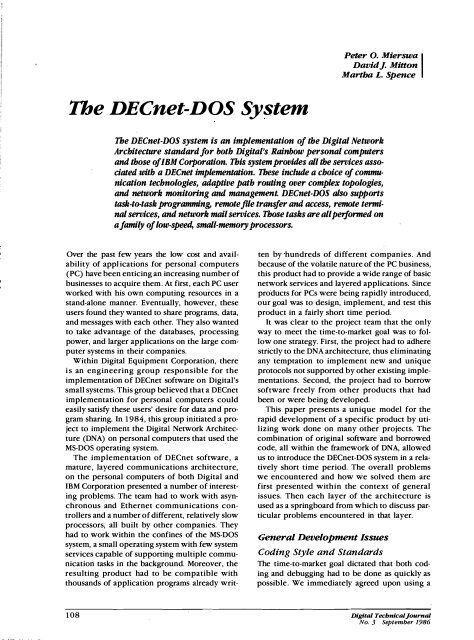DTJ Number 3 September 1987 - Digital Technical Journals
DTJ Number 3 September 1987 - Digital Technical Journals
DTJ Number 3 September 1987 - Digital Technical Journals
You also want an ePaper? Increase the reach of your titles
YUMPU automatically turns print PDFs into web optimized ePapers that Google loves.
Peter 0. MierswaIDavid J. MittonMartha L. Sp enceThe DECnet-DOS Sy stemThe DECnet-DOS system is an implementation of the <strong>Digital</strong> NetworkArchitecture standard fo r both <strong>Digital</strong>'s Rainbow personal computersand those of IBM Corporation. This system provides all the services associatedwith a DECnet implementation. These include a choice of communicationtechnologies, adaptive path routing over complex topologies,and network monitoring and management. DECnet-DOS also supp ortstask-to-task programming, remote file transfer and access, remote terminalservices, and network mail services. Those tasks are all performed ona family of low-speed, small-memory processors.Over the past few years the low cost and availabilityof appl ications for personal computers(PC) have been enticing an increasing number ofbusinesses to acquire them. At first, each PC userworked with his own computing resources in astand-alone manner. Eventually, however, theseusers found they wanted to share programs, data,and messages with each other. They also wantedto take advantage of the databases, processingpower, and larger applications on the large computersystems in their companies.Within <strong>Digital</strong> Equipment Corporation, thereis an engineering group responsible for theimplementation of DECnet software on <strong>Digital</strong>'ssmall systems. This group believed that a DECnetimplementation for personal computers couldeasily satisfy these users' desire for data and programsharing. In 1984, this grop initiated a projectto implement the <strong>Digital</strong> Network Architecture(DNA) on personal computers that used the·MS-DOS operating system.The implementation of DECnet software, amature, layered communications architecture,on the personal computers of both <strong>Digital</strong> andIBM Corporation presented a number of interestingproblems. The team had to work with asynchronousand Ethernet communications controllersand a number of different, relatively slowprocessors, all built by other companies. Theyhad to work within the confines of the MS-DOSsystem, a small operating system with few systemservices capable of supporting multiple communicationtasks in the background. Moreover, theresulting product had to be compatible withthousands of application programs already writ-ten by hundreds of different companies. Andbecause of the volatile nature of the PC business,this product had to provide a wide range of basicnetwork services and layered applications. Sinceproducts for PCs were being rapidly introduced,our goal was to design, implement, and test thisproduct in a fairly short time period.It was clear to the project team that the onlyway to meet the time-to-market goal was to followone strategy. First, the project had to adherestrictly to the DNA architecture, thus eliminatingany temptation to implement new and uniqueprotocols not supported by other existing implementations.Second, the project had to borrowsoftware freely from other products that hadbeen or were being developed.This paper presents a unique model for therapid development of a specific product by utilizingwork done on many other projects. Thecombination of original software and borrowedcode, all within the framework of DNA, allowedus to introduce the DECnet-DOS system in a relativelyshort time period. The overall problemswe encountered and how we solved them arefirst presented within the context of generalissues. Then each layer of the architecture isused as a springboard from which to discuss particularproblems encountered in that layer.General Development IssuesCoding Style and StandardsThe time-to-market goal dictated that both codingand debugging had to be done as quickly aspossible. We immediately agreed upon using a108<strong>Digital</strong> Tecbnical]ournalNo. 3 <strong>September</strong> 1986









